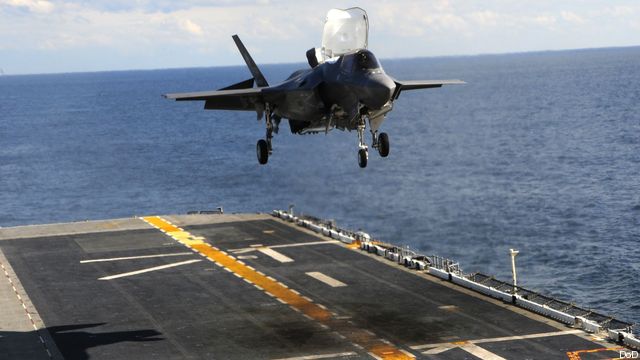
The big news today: the Marines F-35B made a vertical landing on the deck of the USS Wasp, a small Marine aircraft carrier. Ship trials will demonstrate how the stealth materials on the plane hold up to harsh conditions at sea, as well as show just how hot and noisy the aircraft is when making landings on a carrier. There have been concerns that the enormous thrust and heat from the 43,000 pounds of thrust the engine can produce might soften carrier decks and require extra measures to cope with the stresses. So far, program officials say they have seen no evidence of that during the aircraft’s land-based tests.
We know next to nothing about the test results beyond what is contained in the following release from the Joint Strike fighter program office:
Marine Corps test pilot Lt. Col. Fred Schenk landed BF-2 at 3:12 pm. “It was exactly like we predicted,” said Schenk. “But that’s because of all the hard work and extensive preparation done by the Wasp and JSF team.”
The first vertical landing is part of the initial ship trials for the F-35B which started Monday and is expected to last two-weeks. The tests are scheduled to collect data on the aircraft’s ability to perform short take-offs and vertical landings on a ship at sea, as well as determine how the aircraft integrates with the ship’s landing systems, and deck and hangar operations.
“This test period, the first of three scheduled at-sea test periods over the course of the development program, will also collect environmental data on the deck through added instrumentation to measure the F-35B’s impact to flight deck operations.
“The first at sea vertical landing is a huge milestone,” said Marine Corps Col. Roger Cordell, military site director for F-35 test and evaluation at Naval Air Station Patuxent River. “We’re still early in this test period, and we expect to learn a lot more, but this is a great step toward delivering the capability to the fleet.”
Wasp spent time in a shipyard earlier this year, preparing for the F-35 test period; adding specialized instrumentation to measure deck environmental effects.
Norway’s top officer on his ‘biggest challenge,’ next frigate and new NATO neighbors
Gen. Eirik Kristoffersen, Norway’s Chief of Defense, talks to Breaking Defense about his plans for spending on new frigates and subs, the challenges of upgrading Norway’s “digital backbone” and refilling the military’s stocks.


























